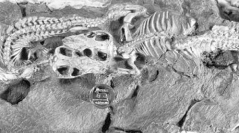

 Comptes Rendus Palevol
4 (6-7) - Pages 623-636
Comptes Rendus Palevol
4 (6-7) - Pages 623-636The southern half of the main Karoo Basin in South Africa contains an almost continuous stratigraphic record of terrestrial sedimentation through the Permo-Triassic boundary (PTB). Detailed logging of multiple sections through the boundary sequence has defined the end-Permian mass extinction event using vertebrate fossils as well as a synchronous change in fluvial style reflecting a rapid aridification of climate. Field data demonstrates a 69% mass extinction of Late Permian terrestrial vertebrates lasting some 300 kyr terminating at the PTB, followed by a lesser extinction event (31%) approximately 160 kyr later involving four survivor taxa that crossed the PTB. The Early Triassic recovery fauna comprises proterosuchian archosauromorphs (Proterosuchus), small amphibians (Micropholis, Lydekkerina), small procolophonoids (‘Owenetta’ kitchingorum, Procolophon ), medium-sized dicynodonts (Lystrosaurus) and small insectivorous cynodonts (Progalesaurus, Galesaurus, Thrinaxodon). Taphonomic bias towards preferential preservation of drought accumulations in the Early Triassic has probably over-emphasized the abundance and diversity of semi aquatic and burrowing animals. .
Terrestrial vertebrates, mass extinction, recovery, Permo-Triassic boundary (PTB), Karoo Basin, South Africa